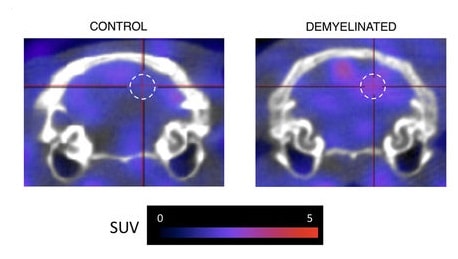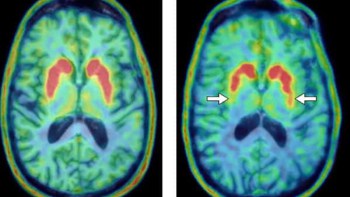
Demyelination – the loss or damage of the myelin that surrounds and insulates nerves – is the hallmark of the neurological disorder multiple sclerosis (MS). When segments of this protective membrane are damaged, nerve impulses can be disrupted, causing symptoms ranging from tingling and numbness to weakness, pain and paralysis. Quantitative imaging of demyelination would provide critical clinical insight, but currently there is no reliable way to achieve this.
At present, MRI is used to image demyelination, but it is not quantitative and cannot distinguish between demyelination and inflammation, which often coexist in MS. Now, a multi-institutional team in the USA has described early results of a novel minimally-invasive method to assess myelin damage using PET (Scientific Reports 8 607).
The PET scans employ a tracer designed to target voltage-gated potassium channels, which are found on demyelinated axons. “In healthy myelinated neurons, potassium channels are usually buried underneath the myelin sheath,” explained study author Brian Popko from the University of Chicago. “When there is loss of myelin, these channels become exposed. They migrate throughout the demyelinated segment and their levels increase.”
These exposed neurons leak intracellular potassium. This leaves them unable to propagate electrical impulses, which causes some of the neurological symptoms seen in MS. “So we developed a PET tracer that can target potassium channels,” Popko said.
The team started with an existing MS drug, 4-aminopyridine, which binds to exposed potassium channels. The drug can partially restore nerve conduction and alleviate neurological symptoms in MS patients. Using mouse models of MS, the researchers showed that the drug accumulated in demyelinated areas of the central nervous system.
They then examined fluorine-containing derivatives of 4-aminopyridine for binding to axonal potassium channels. They found that 3-fluoro-4-aminopyridine (3F4AP) had the desired properties and labelled it with fluorine-18 to enable PET imaging. “We were able to show, in rats, that the tracer accumulated to a higher degree in demyelinated areas than in control areas,” said Popko.
“All existing PET tracers used for imaging demyelination bind to myelin and, consequently, demyelinated lesions show as decreases in signal, which can be problematic for imaging small lesions,” explained first author Pedro Brugarolas, currently at MGH/Harvard Medical School. “3F4AP is the first tracer whose signal increases with demyelination, potentially solving some of the problems of its predecessors.”
Finally, in collaboration with scientists at the National Institutes of Health, the researchers conducted a study in healthy monkeys. They confirmed that radiolabelled 3F4AP entered the brain of primates and localized to areas where there was little myelin.
“We think that this PET approach can provide complementary information to MRI, which can help us follow MS lesions over time,” said Popko. “It has the potential to track responses to remyelinating therapies, an unmet need. This approach should also help determine how much disruption of the myelin sheath contributes to other central nervous system disorders.”



